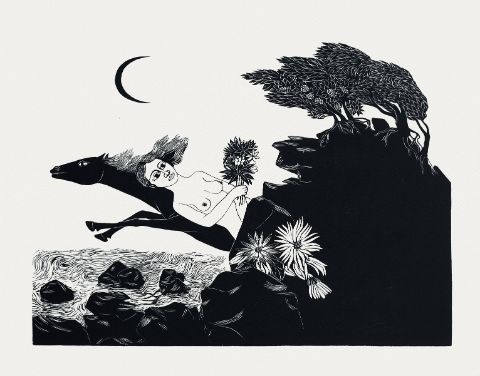Santos Chávez

Santos Chávez, Mi amada viene del mar (1994). Courtesy of Fundación Santos Chávez
Graphic artist Santos Chávez left Chile in 1977, self-exiled from the Chilean dictatorship, and after four years spent between Venezuela, Spain, Sweden, and East and West Germany, he settled in East Berlin in 1981, where he lived until 1994. During his life in the German Democratic Republic (GDR), Chávez was a member of the Verband Bildender Künstler der DDR [Association of visual artists of the GDR], and participated in the local art and literary scene as both an artist and book illustrator. Chávez grew up in Chile’s Mapuche territory, and his experience of herding sheep and cultivating the land marked his poetics of engraving as an assertion of Mapuche culture and aspirations. Chávez began studying art in 1958 in evening courses at the Sociedad de Bellas Artes in Concepción, where he was particularly influenced by the aesthetics of Mexican muralism. The 60s in Chile saw engraving come to the fore and in 1960, Chávez continued to study at the Taller 99 engraving workshop in Santiago, where he consolidated his skills in wood engraving, choosing the material on account of its connection to the land and forest in Mapuche culture. In 1972, he extended his practice to the public sphere, a prime example being his large wood-carved mural for the UNCTAD III building in Santiago, an emblematic construction during the socialist government of Salvador Allende and where public spaces integrated art as means of cultural democratization. Chávez’s works are deeply characterized by the Mapuche cosmovision, where human beings, the elements, and the cosmos form one entity—within this, the landscape, the weather, as well as human and non-human life are all regarded as having equal agency. In the GDR, the artist continued to practise this aesthetic language, painting, for example, a fourteen-metre mural with motifs of Mapuche life for a kindergarten in Salzwedel or participating in the Intergrafik Triennale in the RDA, incorporating elements of the surrounding landscape and everyday life in several of his works.
Works in the exhibition (From Left to Right): Tierra del Sur (1985), reproduction of a woodcut print, 65 × 75 cm; Astro creador de mi pueblo [Astro creator of my people] (1968), reproduction of a woodcut print, 45 × 50 cm; Homenaje a Santiago Nattino/Niña con flores (1985), reproduction of a woodcut print, 45 × 67 cm; Mi amada viene del mar (1994), reproduction of a woodcut print, 90 × 69 cm; Pastor dormido (1984), reproduction of a linoleum print, 35 × 27 cm; Viento del mar (1981), reproduction of a woodcut print, 50 × 40 cm; reproduction of an illustration from page 49 of Roberto Ampuero’s book Ein Känguruh in Bernau (1984), 25 × 30 cm; Una canción para América Latina (1978), reproduction of a woodcut print, 65 × 78 cm. © Santos Segundo Chávez Alister, Chile, © Fundación Cultural Santos y Eva Chávez, Chile, 2024. All courtesy of Fundación Santos Chávez unless otherwise stated